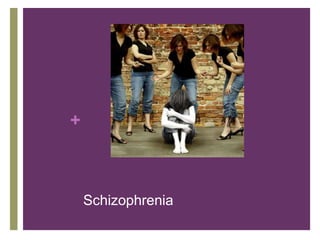
Schizophrenia Symptoms, Causes, and Treatment
- 2. Definition Psychotic disorders characterised by loss of control of the thought processes and inappropriate emotional responses. Most begin in the late teens and early twenties Right: Mathematician John Nash,author Jack Kerouac,Fleetwood Mac guitarist Peter Green, and musician Syd Barrett (Pink Floyd).
- 3. Symptoms Most distinctive: Disturbance of thought, perception and language Often suffer from delusions (false beliefs despite evidence to the contrary).
- 4. Symptoms (cont’d) Hallucinations – perceptual experiences that distort or occur without external stimulation. Auditory hallucinations are the most common kind Loosening of association – tendency of conscious thought to move along associative lines rather than to be controlled, logical and purposeful. (e.g. “She came in last night from Denver, in like a lion, she’s the king of beasts”)
- 5. Positive and Negative symptoms Positive symptoms, such as delusions, hallucinations and loose associations are most apparent in acute phases of the illness and are often treatable by antipsychotic medications. Two kinds of positive:disorganised (inappropriate emotions, disordered thought, bizarre behaviour) and psychotic (delusions and hallucination) Negative symptoms include flat affect, lack of motivation, socially inappropriate behaviour, withdrawal from relationships, intellectual impairments. Positive and negative symptoms appear to involve different neural circuits and to respond to different kinds of medications
- 6. DSM-IV subtypes of schizophrenia 1) Catatonic At least TWO of the following: extreme motor immobility; purposeless excessive motor activity; extreme negativism (motionless resistance to all instructions) or mutism (refusing to speak); peculiar or bizarre voluntary movements; echolalia 2) Disorganised: All of the following – disorganised speech, disorganisedbehaviour, and inappropriate or flat affect – are prominent in behaviour, but catatonic-type criteria are not met. Delusions or hallucinations may be present, but only in fragmentary or non-coherent form
- 7. Subtypes (cont’d) 3) Paranoid: Preoccupation with delusion/s or auditory hallucinations. Little or no disorganised speech, disorganised or catatonic behaviour, or inappropriate or flat affect 4) Undifferentiated Does not fit any of the subtypes above, but meets the symptom criteria for schizophrenia
- 8. Subtypes (cont’d) 5) Residual: Has experienced at least one episode of schizophrenia, but currently does not have prominent positive symptoms (delusions, hallucinations, disorganised speech or behaviour). However, continues to show negative symptoms (inability to experience pleasure, lack of motivation) and a milder variation of positive symptoms (odd beliefs, eccentric behaviour)
- 9. Theories of schizophrenia Most adopt a diathesis-stress model. Most of the time, this diathesis is genetic, but other cases probably reflect early damage to the brain. Threshold for schizophrenia Genetic vulnerability Environmental component necessary to cross threshold Threshold cannot be crossed Genetically above threshold Genetically at risk Genetically near Not genetically predisposed
- 10. Biology of Schizophrenia Genes undoubtedly play a primary role in the etiology (cause) of schizophrenia The following table is based on data pooled across over 40 studies conducted over nearly 60 years
- 11. Dopamine The dopamine hypothesis suggest that the brain produces too much dopamine. Amphetamines (e.g. crystal meth, speed) increase dopamine activity, and high doses induce psychotic-like symptoms such as paranoia and hallucinations. An amphetamine-induced psychosis is even more likely to occur in people with a predisposition to schizophrenia. Also, many patients respond to antipsychotic medication that block dopamine from binding with postsynaptic receptors. The result is a reduction or elimination of positive symptoms
- 12. Neural atrophy and dysfunction Neural atrophy: Enlargement of fluid cavities in the brain called ventricles. Indicates neural regions surrounding them have degenerated. Larger ventricles seen in patients with chronic schizophrenia. Not exclusive to schizophrenia, also observed in other patients with psychotic disorders and even in patients with recurring depression and anxiety disorders. Degeneration/wasting away of a body organ
- 13. Atrophy Most apparent in temporal and frontal lobes, and in the neural tissue connecting the frontal lobes to emotion-processing circuits in the limbic system.
- 14. One study found severity of symptoms, especially auditory hallucinations, correlated strongly with the degree of atrophy in a region of the left temporal cortex specialised for auditory processing of language.
- 15. The prefrontal cortex is another very likely site because one section is involved in working memory and another in social and emotional functioning.
- 16. Prevalence In Australia, around 40,000 people (0.2% of population) have been diagnosed with schizophrenia (Access Economics, 2002). Many studies find the rate is higher among economically impoverished groups… effect on poverty OR difficulty holding employment? 12 times more likely to die by suicide than the general population In Australia, 60% of males with schizophrenia will attempt suicide at some time in their lives. Agar, Argyle and Aderhold (2003) found that patients who had been sexually and/or physically abused as a child were four times more likely to experience hallucinations and 15 times more likely to hear voices than patients who had not been abused.
- 17. Treatment Individual, Group and Family Therapy- can help patient and family understand the disease and symptom triggers- teaches families communication skills- provides resources for dealing with emotional and practical challenges Social skills training- In hospital or community settings- teaches social, self-care and vocational skills Medications- neuroleptic medications to clarify thinking and perceptions of reality and to reduce hallucinations and delusions- drug treatment must be consistent to be effective. Inconsistent dosage may aggravate existing symptoms or create new ones.
- 18. Recovery Estimates vary: 10 to 20% ever fully recover. Less than half show even moderate improvement, and for for those who have shown improvement, almost half fall ill again within a year People with good premorbid (prior to falling ill) social functioning are least likely to relapse over time